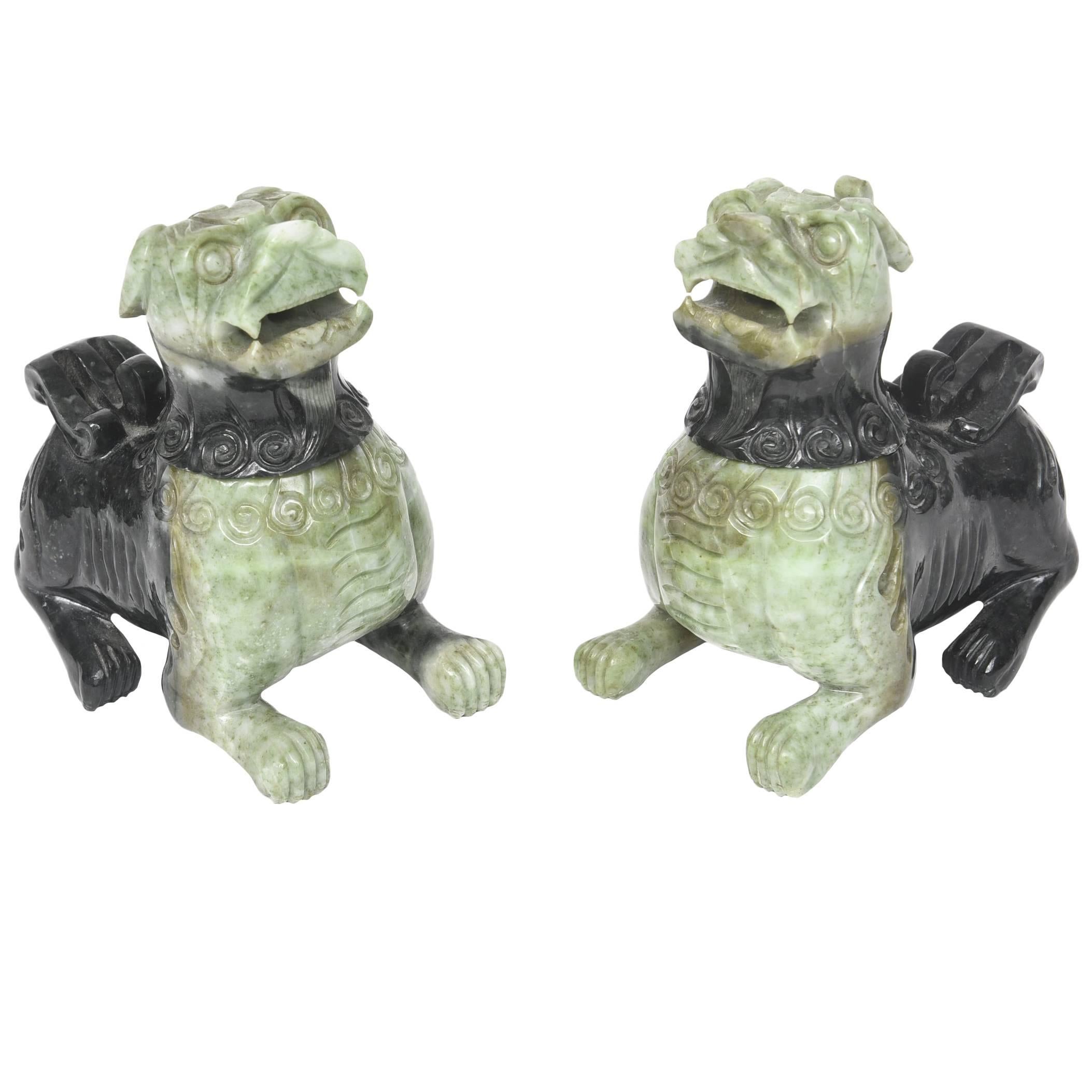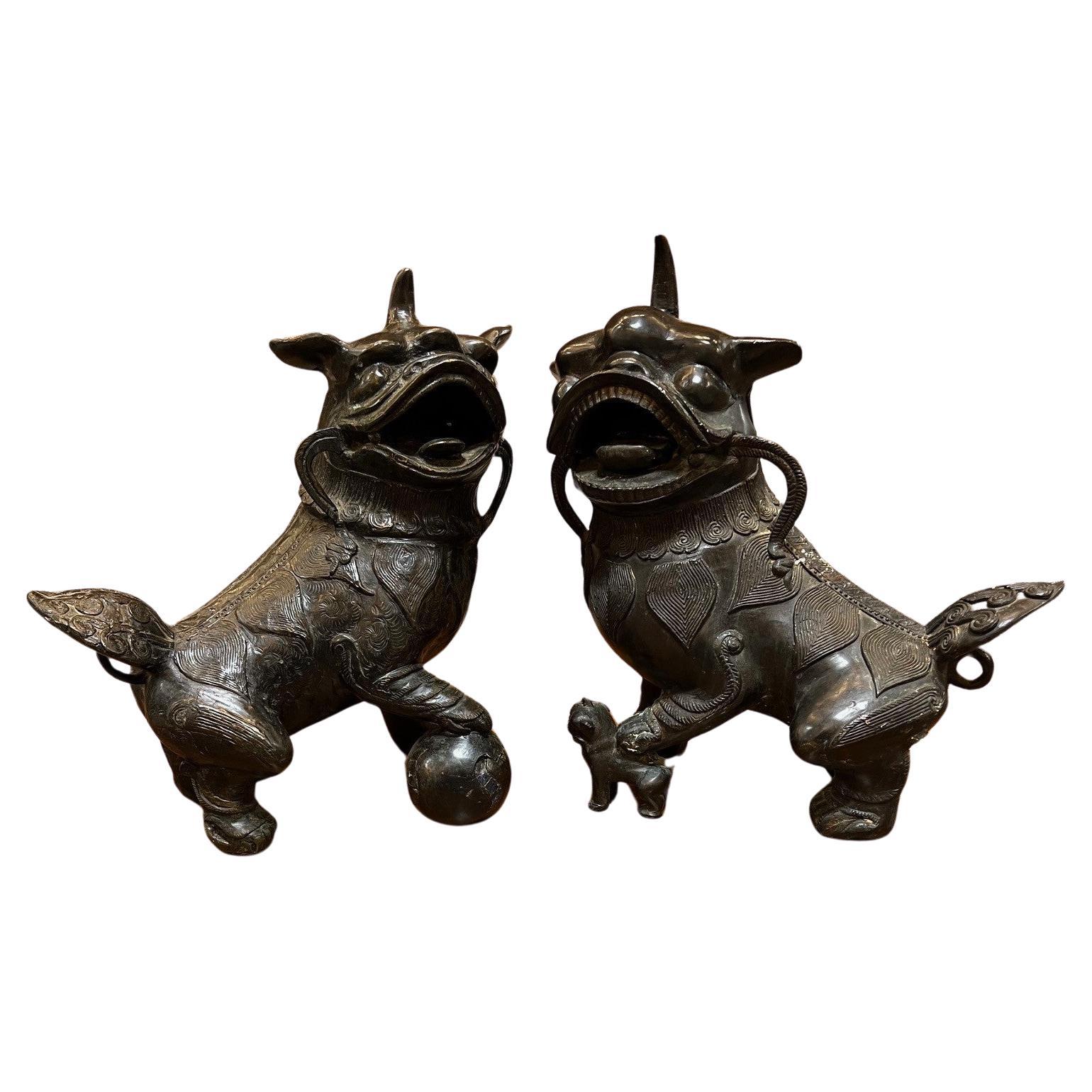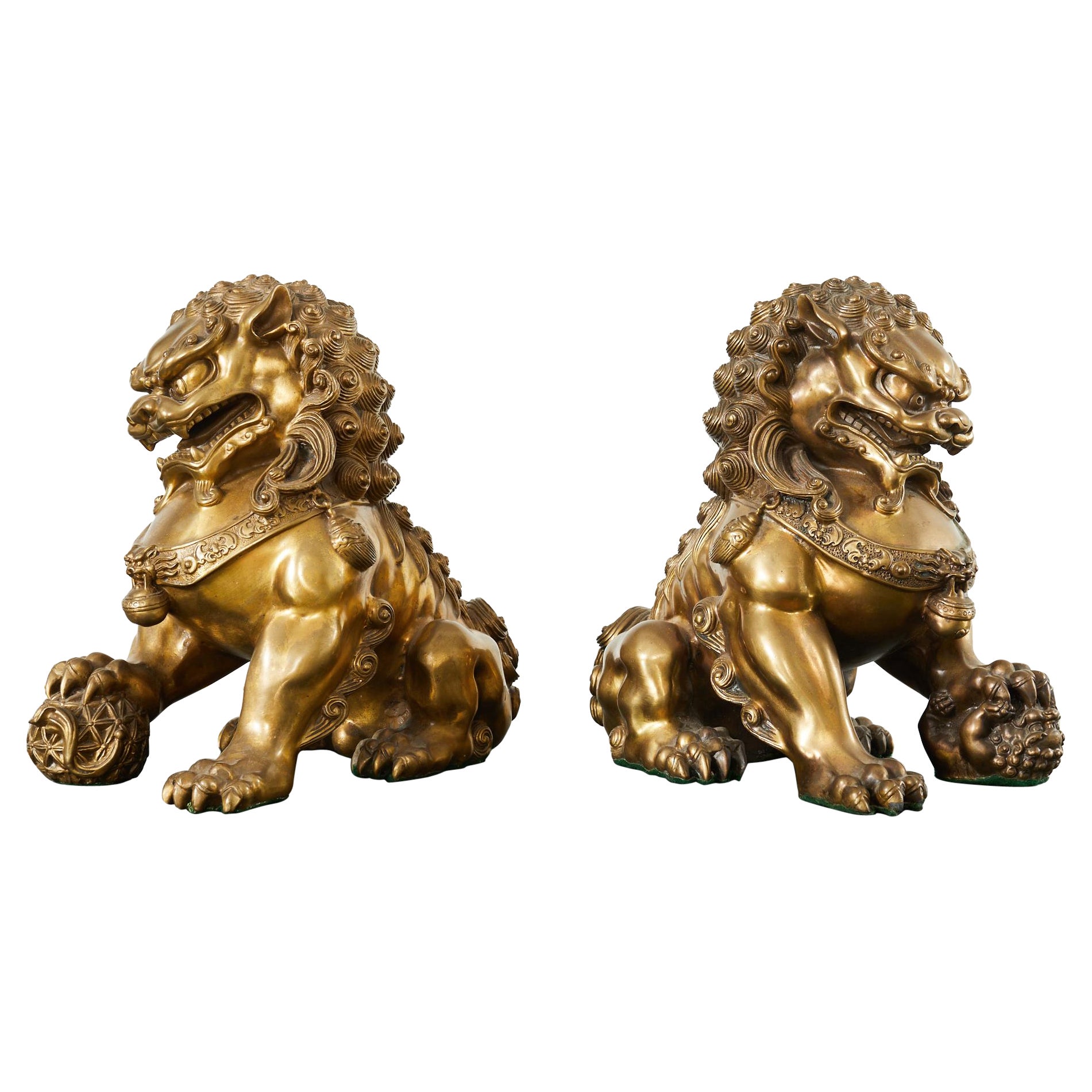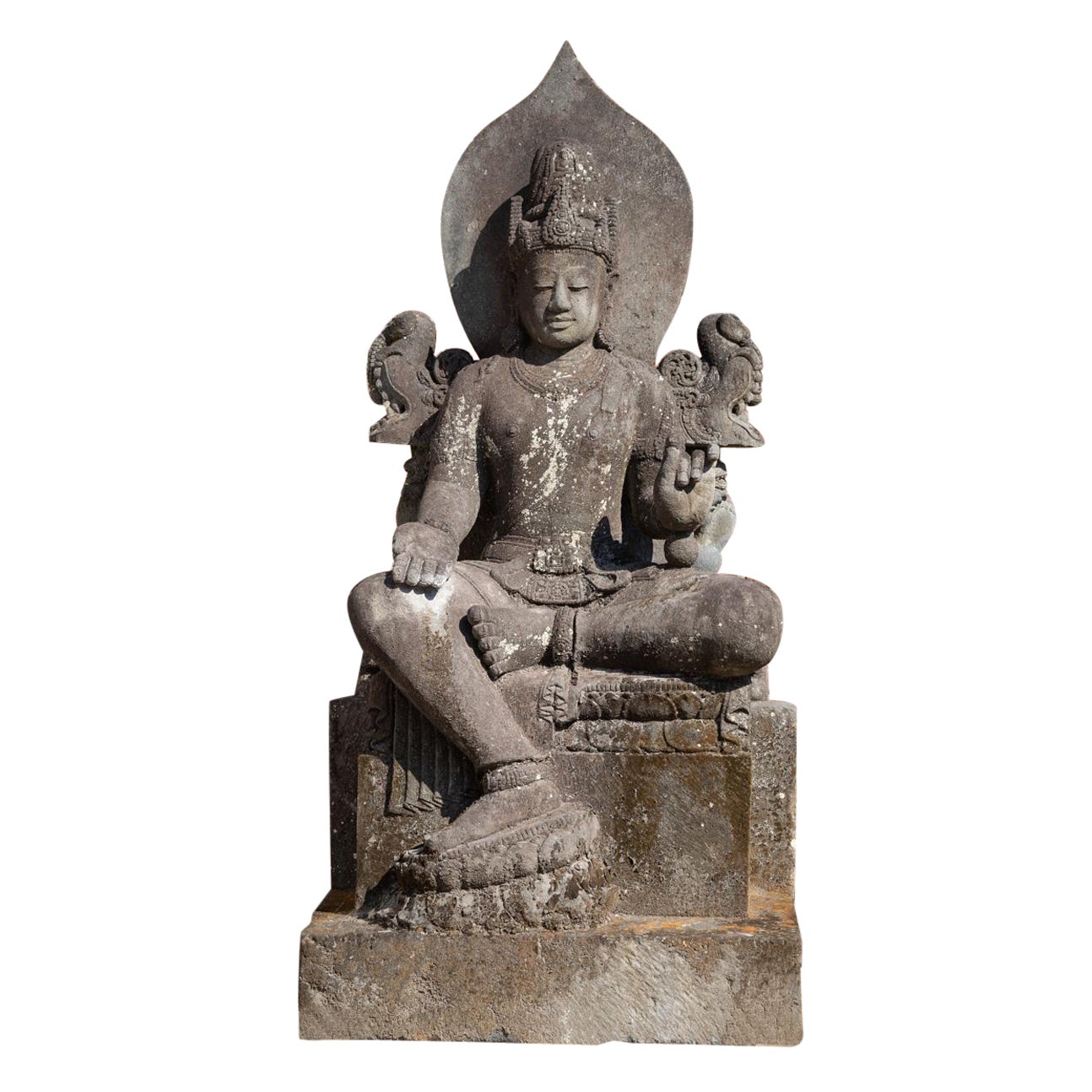Items Similar to Mid-20th century a set of old lavastone Chinese temple lions - Foo dogs
Video Loading
Want more images or videos?
Request additional images or videos from the seller
1 of 22
Mid-20th century a set of old lavastone Chinese temple lions - Foo dogs
About the Item
These lavastone sculptures, originating from Indonesia in the middle of the 20th century, are both impressive and distinctive. Each sculpture stands tall at 77 cm, with dimensions of 40 cm in width and 59 cm in depth. Crafted from lavastone, they embody the natural beauty and unique texture of volcanic rock.
These sculptures are substantial in weight, with each estimated to be around +/- 150 kg. Despite their weight, they can be shipped worldwide, allowing art enthusiasts and collectors from around the globe to appreciate their craftsmanship and cultural significance.
Indonesia, renowned for its rich artistic heritage, has a long history of lavastone sculpture craftsmanship, and these pieces are no exception. Whether displayed indoors or outdoors, these lavastone sculptures are a testament to the artistry of Indonesian artisans and the enduring allure of lavastone as a medium. They make a striking addition to any space, offering a glimpse into the beauty of Indonesian culture.
Material : lavastone
77 cm high
40 cm wide and 59 cm deep
Estimated weight : +/- 150 kg each
Middle 20th century
Can be shipped worldwide
Originating from Indonesia
- Dimensions:Height: 30.32 in (77 cm)Width: 15.75 in (40 cm)Depth: 23.23 in (59 cm)
- Materials and Techniques:
- Place of Origin:
- Period:
- Date of Manufacture:Mid-20th century
- Condition:
- Seller Location:DEVENTER, NL
- Reference Number:
About the Seller
5.0
Gold Seller
These expertly vetted sellers are highly rated and consistently exceed customer expectations.
Established in 1997
1stDibs seller since 2022
20 sales on 1stDibs
Typical response time: 9 hours
- ShippingRetrieving quote...Ships From: DEVENTER, Netherlands
- Return PolicyA return for this item may be initiated within 14 days of delivery.
More From This SellerView All
- Mid 20th century large old lavastone figure of Bodhisattva AvalokiteshvaraLocated in DEVENTER, NLThe very large old lavastone figure of Bodhisattva Avalokiteshvara is an awe-inspiring and monumental work of art originating from Indonesia. Crafted from lavastone, this magnificent...Category
Mid-20th Century Indonesian Sculptures and Carvings
MaterialsLava
- Mid 20th Century Old lavastone Stupa from Indonesia OriginalBuddhasLocated in DEVENTER, NLThe old lavastone Stupa is a remarkable architectural masterpiece crafted from lavastone, known for its durability and timeless beauty. Standing at an impressive height of 124 cm and...Category
Mid-20th Century Sculptures and Carvings
MaterialsLava
- Mid 20th Century Old lavastone Ganesha statue from IndonesiaLocated in DEVENTER, NLAdd a touch of divine energy to your space with this captivating Old Lavastone Ganesha Statue. Crafted from durable lavastone, this statue stands tall at 88 cm, commanding attention ...Category
Mid-20th Century Indonesian Sculptures and Carvings
MaterialsStone
- Mid 20th Century Large old lavastone Buddha statue - OriginalBuddhaLocated in DEVENTER, NLLarge old lavastone Buddha statue Material : lavastone 115 cm high 80 cm wide and 59 cm deep Estimated weight : 450 kg Dharmachakra mudra Middle 20th century Can be shipped worldwide...Category
Mid-20th Century Indonesian Sculptures and Carvings
MaterialsLava
- Mid-20th century very large old lavastone figure of Bodhisattva AvalokiteshvaraLocated in DEVENTER, NLThe very large old lavastone figure of Bodhisattva Avalokiteshvara is a truly impressive and monumental work of art. Crafted from lavastone, a material that holds cultural and geolog...Category
Mid-20th Century Sculptures and Carvings
MaterialsLava
- Mid-20th century large old lavastone Buddha statue from IndonesiaLocated in DEVENTER, NLThe large old lavastone Buddha statue commands attention with its majestic presence, carved from durable lavastone that has withstood the test of time. Standing at an impressive heig...Category
Mid-20th Century Indonesian Sculptures and Carvings
MaterialsLava
You May Also Like
- Mid-20th Century Pair of Chinese Carved Green Hardstone Foo Dogs / LionsLocated in Miami Beach, FLBi-color green hardstone carved to represent a pair of traditional Chinese foo dogs and lions. The heads of these impressive creatures come off so they can be used as incense burners.Category
Mid-20th Century Chinese Animal Sculptures
MaterialsOther
- A pair of 19th Century carved Foo temple dogs or Chinese guardian LionsLocated in London, GBChinese guardian lions, or imperial guardian lions, are a traditional Chinese architectural ornament. Typically made of stone, they are also known as stone lions or shishi (石獅; shíshī). They are known in colloquial English as lion dogs or foo dogs / fu dogs. The concept, which originated and became popular in Chinese Buddhism, features a pair of highly stylized lions—often one male with a ball and one female with a cub—which were thought to protect the building from harmful spiritual influences and harmful people that might be a threat. Used in imperial Chinese palaces and tombs, the lions subsequently spread to other parts of Asia including Japan (see komainu), Korea, Philippines, Tibet, Thailand, Myanmar, Vietnam, Sri Lanka, Nepal, Cambodia, Laos, and Malaysia. There has been extensive interaction between Chinese mythology and Confucianism, Taoism, and Buddhism. Elements of pre-Han dynasty mythology such as those in Classic of Mountains and Seas were adapted into these belief systems as they developed (in the case of Taoism), or were assimilated into Chinese culture (in the case of Buddhism). Elements from the teachings and beliefs of these systems became incorporated into Chinese mythology. For example, the Taoist belief of a spiritual Paradise became incorporated into mythology as the place where immortals and deities used to dwell. Sometimes mythological and religious ideas have become widespread across China's many regions and diverse ethnic societies. In other cases, beliefs are more limited to certain social groups, for example, the veneration of white stones by the Qiang. One mythological theme that has a long history and many variations involves a shamanic world view, for example in the cases of Mongolian shamanism among the Mongols, Hmong shamanism among the Miao people, and the shamanic beliefs of the Qing dynasty from 1643 to 1912, derived from the Manchus. Politically, mythology was often used to legitimize the dynasties of China, with the founding house of a dynasty claiming a divine descent. Mythology and philosophy. Further information: Chinese philosophy True mythology is distinguished from philosophical treatises and theories. Elaborations on the Wu Xing are not really part of mythology, although belief in five elements could appear. The Hundred Schools of Thought is a phrase suggesting the diversity of philosophical thought that developed during the Warring States of China. Then, and subsequently, philosophical movements had a complicated relationship with mythology. However, as far as they influence or are influenced by mythology, divides the philosophical camps into two rough halves, a Liberal group and a Conservative group. The liberal group being associated with the idea of individuality and change, for example as seen in the mythology of divination in China, such as the mythology of the dragon horse that delivered the eight bagua diagrams to Fu Xi, and methods of individual empowerment as seen in the Yi Jing (Book of Changes). The Liberal tendency is towards individual freedom, Daoism, and Nature. The relationship of the Conservative philosophies to mythology is seen in the legendary Nine Tripod Cauldrons, mythology about the emperors and central bureaucratic governance, Confucianism, written histories, ceremonial observances, subordination of the individual to the social groups of family and state, and a fixation on stability and enduring institutions. The distinction between the Liberal and Conservative is very general, but important in Chinese thought. Contradictions can be found in the details, however these are often traditional, such as the embrace by Confucius of the philosophical aspects of the Yi Jing, and the back-and-forth about the Mandate of Heaven wherein one dynasty ends and another begins based according to accounts (some of heavily mythological) where the Way of Heaven results in change, but then a new ethical stable dynasty becomes established. Examples of this include the stories of Yi Yin, Tang of Shang and Jie of Xia or the similar fantastic stories around Duke of Zhou and King Zhou of Shang. Mythology exists in relationship with other aspects of society and culture, such as ritual. Various rituals are explained by mythology. For example, the ritual burning of mortuary banknotes (Hell Money), lighting fireworks, and so on. A good example of the relationship of Chinese mythology and ritual is the Yubu, also known as the Steps or Paces of Yu. During the course of his activities in controlling the Great Flood, Yu was supposed to have so fatigued himself that he lost all the hair from his legs and developed a serious limp. Daoist practitioners sometimes incorporate a curiously choreographed pedal locomotion into various rituals. Mythology and practice, one explains the other: in these rituals, the sacred time of Yu merges with the sacral practice of the present. Various ideas about the nature of the earth, the universe, and their relationship to each other have historically existed as either a background or a focus of mythologies. One typical view is of a square earth separated from a round sky by sky pillars (mountains, trees, or undefined). Above the sky is the realm of Heaven, often viewed of as a vast area, with many inhabitants. Often the heavenly inhabitants are thought to be of an "as above so below" nature, their lives and social arrangements being parallel to those on earth, with a hierarchical government run by a supreme emperor, many palaces and lesser dwellings, a vast bureaucracy of many functions, clerks, guards, and servants. Below was a vast under ground land, also known as Diyu, Yellow Springs, Hell, and other terms. As time progressed, the idea of an underground land in which the souls of the departed were punished for their misdeeds during life became explicit, related to developments in Daoism and Buddhism. The underground world also came to be conceived of as inhabited by a vast bureaucracy, with kings, judges, torturers, conductors of souls, minor bureaucrats, recording secretaries, similar to the structure of society in the Middle Kingdom (earthly China). Chinese temple Dogs...Category
Antique 1860s Chinese Chinese Export Sculptures and Carvings
MaterialsHardwood
- Mid 20th Century Bronze Pair of Foo DogsLocated in Stamford, CTThis is a nice pair of bronze Foo Dogs with a male and female with baby. They would look great in a garden or entrance to your home or garden. Foo Dogs also known as Guardian Lions s...Category
Mid-20th Century Sculptures and Carvings
MaterialsBronze
- Pair of Chinese Bronzed Metal Buddhist Temple Foo Dogs LionsLocated in Rio Vista, CASpectacular pair of Chinese Buddhist guardian temple foo dogs or foo lions intricately crafted from bronzed metal. The lions are depicted sitting with one having a paw on a ball or o...Category
20th Century Chinese Qing Sculptures and Carvings
MaterialsMetal
- Pair Early 20th Century Chinese Ceramic Foo DogsLocated in Silvolde, GelderlandLow fired ceramic Chinese "Ming" style pair matching Foo Dogs with beautiful cracked and dripped glazed four color finish. This beautiful couple Foo Dogs is visibly handmade because the prints of the fingers the artist are visible in the earthenware. These Foo Dogs makes displayed in your place a great...Category
Early 20th Century Chinese Ming Ceramics
MaterialsEarthenware
- Large Pair of Bronze Singha Temple Lions, Foo Dogs.Located in Stamford, CTA magnificent pair of bronze Singha Temple Lions, a Thai mythical creature in the form of a lion that has been a big part of Thai history guarding the entrances to the many Buddhist ...Category
Late 20th Century Thai Sculptures and Carvings
MaterialsBronze
Recently Viewed
View AllMore Ways To Browse
Buddhist Pendant
Showa Incense
Black Jade Statue
Inari Kitsune
Bell And Dorje
Fukagawa Seiji
Hokkaido Bear
Hindu Torso
Antique Ivory Netsukes
Japanese Wood Root Carving
Carved Chinese Limestone
Set Asian Carving Wall
Chinese Temple Pieces
Guilt Bronze Buddha
Chinese Drapes
Catholic Bishop Statue
Jia Jia Jewelry
Koi Fish Lantern





